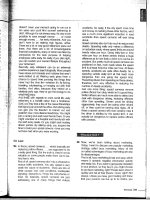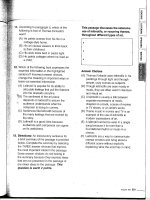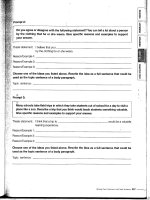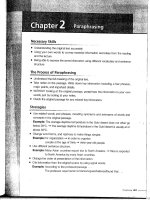The creative teacher 2nd edition
Bạn đang xem bản rút gọn của tài liệu. Xem và tải ngay bản đầy đủ của tài liệu tại đây (19.1 MB, 581 trang )
2
Copyright © 2014 by McGraw-Hill Education. All rights reserved.
Except as permitted under the United States Copyright Act of
1976, no part of this publication may be reproduced or
distributed in any form or by any means, or stored in a data base
or retrieval system, without the prior written permission of the
publisher.
ISBN: 978-0-07-183965-5
MHID:
0-07-183965-8
The material in this eBook also appears in the print version of
this title: ISBN: 978-0-07-180109-6, MHID: 0-07-180109-X.
eBook conversion by codeMantra
Version 1.0
All trademarks are trademarks of their respective owners. Rather
than put a trademark symbol after every occurrence of a
trademarked name, we use names in an editorial fashion only,
and to the benefit of the trademark owner, with no intention of
infringement of the trademark. Where such designations appear
in this book, they have been printed with initial caps.
McGraw-Hill Education products are available at special
quantity discounts to use as premiums and sales promotions or
for use in corporate training programs. To contact a
representative, please visit the Contact Us pages at
www.mhprofessional.com.
TERMS OF USE
This is a copyrighted work and McGraw-Hill Education and its
licensors reserve all rights in and to the work. Use of this work is
subject to these terms. Except as permitted under the Copyright
3
Act of 1976 and the right to store and retrieve one copy of the
work, you may not decompile, disassemble, reverse engineer,
reproduce, modify, create derivative works based upon, transmit,
distribute, disseminate, sell, publish or sublicense the work or
any part of it without McGraw-Hill Education’s prior consent.
You may use the work for your own noncommercial and
personal use; any other use of the work is strictly prohibited.
Your right to use the work may be terminated if you fail to
comply with these terms.
THE WORK IS PROVIDED “AS IS.” McGRAW-HILL
EDUCATION AND ITS LICENSORS MAKE NO GUARANTEES
OR WARRANTIES AS TO THE ACCURACY, ADEQUACY OR
COMPLETENESS OF OR RESULTS TO BE OBTAINED FROM
USING THE WORK, INCLUDING ANY INFORMATION THAT
CAN BE ACCESSED THROUGH THE WORK VIA HYPERLINK
OR OTHERWISE, AND EXPRESSLY DISCLAIM ANY
WARRANTY, EXPRESS OR IMPLIED, INCLUDING BUT NOT
LIMITED TO IMPLIED WARRANTIES OF MERCHANTABILITY
OR FITNESS FOR A PARTICULAR PURPOSE. McGraw-Hill
Education and its licensors do not warrant or guarantee that the
functions contained in the work will meet your requirements or
that its operation will be uninterrupted or error free. Neither
McGraw-Hill Education nor its licensors shall be liable to you or
anyone else for any inaccuracy, error or omission, regardless of
cause, in the work or for any damages resulting therefrom.
McGraw-Hill Education has no responsibility for the content of
any information accessed through the work. Under no
circumstances shall McGraw-Hill Education and/or its licensors
be liable for any indirect, incidental, special, punitive,
consequential or similar damages that result from the use of or
4
inability to use the work, even if any of them has been advised of
the possibility of such damages. This limitation of liability shall
apply to any claim or cause whatsoever whether such claim or
cause arises in contract, tort or otherwise.
5
To obtain material from the disk that accompanies the printed
version of this eBook, please click here.
6
Contents
Preface
Introduction
Book Reports
Submarine Sandwich
Lunch Bag
Book Critic
Book Jacket
Cookin’ Up Books
Read All About It
Bringing Characters to Life
Letter to the Author
Interview a Character
Book Brochure
Book Report Mobile
Descriptive Diary
Character Puppet
Traditional Book Report Format
Additional Ideas for Responding to Literature
Math
Tangrams
Solid Geometry: Three-Dimensional Objects
Dominoes
7
Fractions
Clocks
Pentominoes
Money and Measurement
Graphing
Tens Frames
Hundreds Charts
Calendars
Story Problems
Writing
Story Starters for Daily Journal Writing
Graphic Writing Organizers
Autobiography Recipe
Create a Menu
Create a Newspaper
Science
Exploring Batteries and Lightbulbs
Making Butter
Creating Flubber
Making Ice Cream
Growing Lima Beans
Experimenting with Magnets and Compasses
Raising Mealworms
Building Rockets
Creating a Volcano
Soda Bottle Terrarium
Science Picture Books
8
Social Science
Heritage Report
Historical Figure/Event Report
Personal and Cultural Report
U.S. President Report
National Symbol Inventory
State Report
Community Exploration Group Activity
Careers in Your Community
All About Me Report
Country Report
National Flag Report
Art
Papier-Mâché
Creative Collages
Dioramas
Mobiles
Paper Mosaic
Tissue Paper Art
Ir-resist-ible Art!
Scratch Art
Silhouettes
Mat Weaving
Kid Clay
Suggested Resources
9
Preface
I this second edition of The Creative Teacher, we included the
new ideas we generated but could not fit into our first edition.
We also wanted to incorporate feedback from other teachers
who have reviewed the book and/or asked us to include specific
ideas. This book is meant as a one-stop resource for teachers
who need immediate ideas to make their curriculum more
relevant and engaging. It also includes fresh concepts for
educators searching for something different from and more
interesting than what they have been using.
With these goals in mind, writing this book was as simple as
referring to the many boxes, files, and resource books we have
gathered; websites we visited; and workshops and conferences
we attended over the years. More than anything, we wanted to
organize a resource to help teachers make their curriculum
come to life. The Creative Teacher does just that.
Being teachers ourselves, we developed a list of the many
resources we wished we had had at our fingertips for our own
classrooms. We also discussed key areas that we felt were left out
of many curriculums. It seemed that there was never enough
time or we didn’t have enough information to do justice to
certain curricular areas, such as book reports, math reviews,
social studies research reports, simple science experiments, art
projects, and essay writing. We believe that if there is one
resource teachers can consult for such ideas, there will be less
need for stacks of supplemental materials, which busy teachers
10
rarely have time for.
Revisiting this book was a great experience, and we hope that
new and veteran teachers will find it useful in preparing their
curriculum throughout the year. We continue to add creative
ideas to our own repertoire including resources such as teachermade worksheets, puppets, report guidelines, workshop tips, as
well as the wonderful ideas we have collected from colleagues,
students in our teacher preparation programs, and our current
student teachers. We recognize that there are many amazing
books available to help new and veteran teachers, but we also
know how important this book will be in combining these ideas
offering a one-stop resource.
Kimberly Persiani, EdD
Associate Professor
CSU, Los Angeles
11
Introduction
“The ultimate freedom for creative groups is the freedom to
experiment with new ideas. Some skeptics insist that innovation
is expensive. In the long run, innovation is cheap. Mediocrity is
expensive—and autonomy can be the antidote.” Tom Kelly,
General Manager, IDEO
—Daniel H. Pink, Drive: The Surprising
Truth About What Motivates Us
Many teachers still believe that the best way to motivate
students is with rewards and incentives, but Daniel Pink would
likely say that’s a mistake. He proclaims that the secret to high
performance and satisfaction at school is the deeply human need
to direct our own lives, to learn and create new things, and to do
better by ourselves and our world. The second edition of The
Creative Teacher holds this thought at the forefront as we offer a
variety of subject-specific activities that not only tap into the
Common Core Standards (CCS) but also push for creativity,
innovation, autonomy, critical thinking, and inference to
encourage those new ideas and avoid the mediocrity that Daniel
Pink speaks of.
Why a Second Edition?
With the Common Core Standards coming into play, and the 21st
12
century well under way, this is the perfect time for us to revisit
and update the first edition. We also offer new and interesting
ideas to not only meet the demands of the CCSs but also the
demands of the advancements in digital media as well as the
ever-changing diverse student population.
What’s New?
One of the most important aspects of the second edition is that
the template pages will now be available for download for ease
of use when planning lessons. New templates to help support
activities throughout the book will also be made accessible for
corresponding pages. These templates will be noted by the CD
icon, which serves to remind you that there is a template ready
for your students’ use.
In this edition, you will find a variety of updated activities,
such as new book reports, including one for creating a Social
Network Profile page on story characters or real people from
informational texts. Other responses to literature in the Book
Reports section offer the options of predicting the future
through the “Crystal Ball,” digging around in a story character’s
garbage in “Take Out the Trash,” and solving problems in the
story by writing to “Dear Abby.”
Teachers will be excited to see new Graphic Organizers to
help students keep track of data for writing essays. Some are
related to types of writing, such as compare and contrast;
developing topic ideas for stories; or preparing information to
write history and/or science reports.
Other areas to find new templates and new activities include
13
science. You will enjoy teaching your students how to create a
terrarium with products they can bring from home. Also
included is an ever-popular social studies assignment that asks
students to create a flag or recreate one for a country they are
studying or where their family originates from. And several new
art activities are added. A student favorite is creating tissue
paper scenes, settings, or locations for geography, stories being
read in class, or places they’d like to visit someday. Another art
lesson gives students a chance at creativity by making a collage.
These can be used to model a historical figure, a scene or setting
from a story, or a geographic location.
This book also lends itself to meeting elements of the
Common Core Standards. The Mission of the Common Core
Standards states:
The Common Core State Standards provide a consistent,
clear understanding of what students are expected to learn,
so teachers and parents know what they need to do to help
them. The standards are designed to be robust and relevant
to the real world, reflecting the knowledge and skills that our
young people need for success in college and careers. With
American students fully prepared for the future, our
communities will be best positioned to compete successfully
in the global economy. ( />The Common Core State Standards Initiative is a state-led
effort coordinated by the National Governors Association Center
for Best Practices (NGA Center) and the Council of Chief State
School Officers (CCSSO). The standards were developed in
collaboration with teachers, school administrators, and experts
to provide a clear and consistent framework to prepare our
14
children for college and the workforce.
The standards are informed by the highest, most effective
models from across the United States and around the world, and
they provide teachers and parents with a common
understanding of what students are expected to learn.
Consistent standards will provide appropriate benchmarks for
all students, regardless of where they live.
These standards define the knowledge and skills students
should have within their K-12 education careers so that they will
graduate high school able to succeed in entry-level, creditbearing academic college courses and in workforce training
programs. The standards:
• Align with college and work expectations
• Are clear, understandable, and consistent
• Include rigorous content and application of knowledge through
high-order skills
• Build upon strengths and lessons of current state standards
• Are informed by other top performing countries, so that all
students are prepared to succeed in our global economy and
society
• Are evidence-based ( />It is with great pride that we offer you this new edition.
15
Book Reports
This chapter includes a variety of book report formats ranging
from a few sentences for the early grades, to deeper inference
and higher level prompts for the upper grades. Encouraging a
combination of fiction and nonfiction texts allows for creativity
and student choice while also meeting the Common Core
Standards for English Language Arts and Literacy.* As students
advance through the grades and master grade level standards in
reading, writing, speaking, listening, and language, they are able
to exhibit the following as literate individuals:
1. They demonstrate independence.
16
2. They build strong content knowledge.
3. They respond to the varying demands of audience, task,
purpose, and discipline.
4. They comprehend as well as critique.
5. They value evidence.
6. They use technology and digital media strategically and
capably.
7. They come to understand other perspectives and cultures.
All of this can be accomplished when consistently incorporating
Book Reports and responses to literature into your curriculum.
Submarine Sandwich
Grades 3–12
Materials Needed
Ham—pink construction paper
Lettuce—green construction paper
Tomato—red construction paper
Cheese—orange construction paper
Mayonnaise—white construction paper
Mustard—yellow construction paper
Bread—beige (top and bottom pieces)
17
Brad to hold the submarine sandwich together
Crayons/colored pencils/pens
Student Guidelines
1. On the top slice of bread, students will write the title of the
book, the author, the illustrator (if applicable), the publisher,
and the copyright date. This will teach the student how, what,
and where to look for these elements in every book they use.
2. On the mustard, students will write a summary of the book,
including the sequence of events for the reader to follow.
18
3. On the lettuce, students will describe the main characters in
detail, including physical characteristics if applicable, their
dispositions/personalities, their role in the book, and whether
or not students might be friends with these characters in real
life along with an explanation as to why or why not.
4. On the ham, students will describe the setting of the book.
5. On the cheese, students will describe the turning point, or
climax, of the book.
6. On the tomato, students will list and define five unfamiliar
words from the book.
7. On the mayonnaise, students will draw a picture of a specific
scene in the book that depicts an understanding of the plot.
8. On the bottom slice of bread, students will write their name as
“Written by.…”
9. Connect all of the submarine sandwich ingredients together at
one end with the brad.
19
Lunch Bag
20
Graded 4–12
Materials Needed
Brown lunch bag
5 × 7 index cards
Crayons/colored pencils/pens
21
22
Student Guidelines
• Compile 10 index cards. On each card, students will list a
question and its answer on the front. On the back, they will
illustrate the situation. Five of the questions need to be
directly related to the content of the story. These might
include but are not limited to setting, conflicts, turning point
23
in the story, and so on. Five of the questions need to be
inference questions.
• Using index cards, create a 10-word glossary of unfamiliar
words from the book. Along with writing a definition for each
word, students will write the corresponding sentence from the
book and a sentence of their own.
• On index cards, describe each of the characters. Include their
physical characteristics if applicable, and then describe their
personalities and their roles in the book.
• On the outside front of the brown bag, illustrate one of the
major scenes from the book. Add the book’s title, author,
illustrator, publisher, and copyright date.
• On the outside back of the brown bag, write your name.
• Place the index cards into the brown bag and deliver to the
teacher as if it were a lunch.
Note: This can also be done with shoe boxes, manila envelopes,
cereal boxes, and similar items.
24
FRONT
BACK
25









